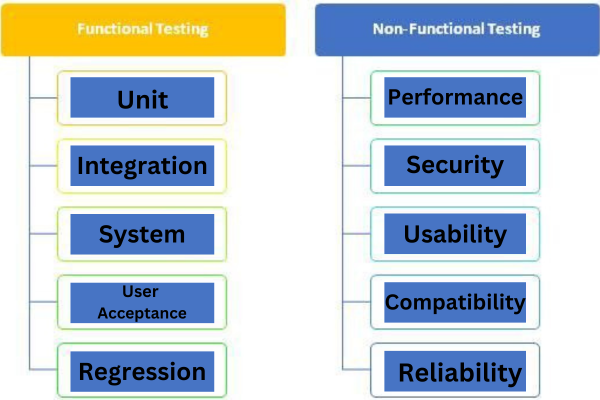Introduction
Software testing is an essential process in the Software Development Life Cycle (SDLC). Without proper testing, software applications may be released with critical defects, leading to poor user experience, security vulnerabilities, and system failures. Ensuring that a software product is thoroughly tested before deployment is crucial for any organization aiming to deliver high-quality and reliable applications.
Testing is broadly classified into two categories: Functional vs non functional testing. Understanding these two categories is fundamental for software testers, developers, and business analysts as they help ensure a product meets all required specifications.
Functional vs non functional testing is centered around verifying that a software application performs as expected, focusing on the features, workflows, and expected behaviors. Functional vs non functional testing ensures that every function of the application operates according to the predefined requirements. On the other hand, non-functional testing assesses other vital aspects such as performance, security, usability, and compatibility. While functional testing answers the question, “Does the application do what it is supposed to do?”, non-functional testing answers, “How well does the application perform under various conditions?”
Both types of testing play a crucial role in software quality assurance. A well-tested software application leads to enhanced customer satisfaction, reduced maintenance costs, and fewer post-production defects. Therefore, gaining expertise in both Functional vs non functional testing is a must for any aspiring software tester. If you are considering enrolling in a QA software testing course, this guide will provide you with in-depth knowledge to help you excel in the field and secure a successful career in software quality assurance.

What is Functional Testing?
Definition
Functional testing verifies that a software application performs according to the specified requirements. It focuses on evaluating whether the system behaves as expected by checking various functions, features, and user interactions.
Key Objectives
- Ensuring that all software functionalities work as intended.
- Validating input and output values.
- Checking integration between different modules.
- Ensuring compliance with business requirements.
Types of Functional Testing
1. Unit Testing
- Conducted at the individual component level.
- Often automated using tools like JUnit (for Java) or NUnit (for .NET).
2. Integration Testing
- Tests interactions between different modules or components.
- Uses approaches like Big Bang, Top-Down, and Bottom-Up Testing.
3. System Testing
- Evaluates the complete and fully integrated application.
- Ensures compliance with functional requirements.
4. User Acceptance Testing (UAT)
- Conducted by end-users to verify real-world functionality.
- Ensures the system is ready for production deployment.
5. Regression Testing
- Ensures that new changes do not negatively impact existing functionalities.
- Often automated using tools like Selenium, QTP, or TestNG.
Real-World Example
Imagine you are testing an e-commerce application. Functional testing will check if:
- Users can search for products.
- The checkout process works correctly.
- Users receive an order confirmation email after a successful purchase.
What is Non-Functional Testing?
Definition
Non-functional testing assesses software performance, security, usability, and other quality attributes that do not relate to specific functionalities. This testing ensures a seamless user experience under different conditions.
Key Objectives
- Enhancing software performance and scalability.
- Ensuring data security and compliance.
- Validating system behavior under various conditions.
Types of Non-Functional Testing
1. Performance Testing
- Measures speed, responsiveness, and stability.
- Includes load testing, stress testing, and endurance testing.
2. Security Testing
- Identifies vulnerabilities to prevent cyber threats.
- Uses tools like OWASP ZAP and Burp Suite.
3. Usability Testing
- Ensures software is user-friendly and intuitive.
- Conducted with real users for feedback.
4. Compatibility Testing
- Verifies software works across different browsers, devices, and OS.
- Uses tools like BrowserStack or Sauce Labs.
5. Reliability Testing
- Ensures software remains stable over prolonged use.
- Evaluates system uptime and error handling.
Real-World Example
For the same e-commerce application, non-functional testing will check:
- Page load time under heavy traffic.
- Encryption and data security for payment transactions.
- Cross-browser compatibility on Chrome, Firefox, and Safari.
Functional vs. Non-Functional Testing: Key Differences
| Aspect | Functional Testing | Non-Functional Testing |
|---|---|---|
| Focus | Validates software functions | Tests performance, security, usability |
| Requirement Type | Business requirements | Quality attributes |
| Tools Used | Selenium, QTP, TestNG | JMeter, LoadRunner, OWASP ZAP |
| Execution Type | Manual and Automated | Mostly Automated |
| Outcome | Ensures correct application behavior | Enhances overall software quality |
Why Functional vs Non Functional Testing Testing Are Crucial
Functional vs non functional testing Software development is a complex process that requires rigorous validation to ensure that applications work as intended. Neglecting any form of testing can lead to software defects, security risks, and performance bottlenecks. Understanding Functional vs Non-Functional Testing is essential for delivering a high-quality software product. Functional vs non functional testing Below are a few reasons why both testing types are necessary:
- Enhanced User Satisfaction: Functional vs Non-Functional Testing plays a critical role in ensuring an optimal user experience. Functional testing guarantees that software behaves as expected, while non-functional testing enhances speed, usability, and security.
- Reduced Maintenance Costs: Identifying and fixing defects early through thorough Functional vs Non-Functional Testing minimizes the cost of future software updates and maintenance. This proactive approach saves businesses significant time and resources.
- Compliance with Industry Standards: Functional vs non functional testing Many industries, such as healthcare, finance, and e-commerce, have strict regulatory requirements that demand comprehensive testing to ensure compliance. Functional vs Non-Functional Testing ensures adherence to these standards by verifying both core functionalities and performance metrics.
- Minimized Business Risks: Well-tested applications are less prone to unexpected failures, which can negatively impact business operations, revenue, and customer trust.
- Improved Market Competitiveness: Software products that undergo extensive Functional vs non functional testing are more competitive in the market due to superior quality, reliability, and user-friendliness.
- Scalability and Performance Assurance: Non-functional testing ensures that software can handle increased workloads and scale efficiently as the user base grows.
- Security Protection: Cybersecurity threats are increasing, and security testing ensures that vulnerabilities are identified and mitigated before attackers can exploit them.
- Seamless Integration with Other Applications: Functional testing ensures that integrations with third-party tools and services work correctly, preventing potential operational issues.
By prioritizing Functional vs Non-Functional Testing, software development teams can create applications that not only meet functional requirements but also excel in performance, security, and user experience. Functional vs non functional testing This comprehensive approach leads to better software quality, reduced risks, and long-term business success.
How QA Tester Training Prepares You for Software Testing Careers
At H2K Infosys, our QA software testing course covers both Functional vs non functional testing methodologies.
What You Will Learn
- Core testing concepts, including manual and automation testing.
- Hands-on experience with tools like Selenium, JMeter, and LoadRunner.
- Real-world testing scenarios with live projects.
- Preparation for quality assurance certification online.
Why Choose H2K Infosys?
- Expert instructors with industry experience.
- Hands-on training with real-world applications.
- QA training placement assistance to kickstart your career.
- Flexible online learning options.
Conclusion
Both Functional vs non functional testing are crucial in software quality assurance. Functional testing ensures correct functionality, while non-functional testing ensures optimal performance and security. To become a skilled software tester, mastering both is essential.
Ready to launch your QA career? Enroll in H2K Infosys’ QA software testing course today and gain hands-on expertise with industry-leading tools!


























101 Responses
Non Functional characteristics of software :-
a.) Maintainability ; The software should not pose any technical issues, while the users use the software.
b.) Reliability ; It should provide the stable outcome without any ambiguity.
c.) Efficiency ; It is related with the speed of the software. It should be quick in responding to the user requests.
d.) User friendly ; It should be user friendly with important functionalities highlighted. It should be easy and simple for a common user.
e.) Portability ; End users should be able to use the software on different devices with different configuration. It should be usable on different devices which is used by users.
1. Identify the difference between functional and non functional testing.
Functional Testing is the type of testing done against the business requirements of application. It is a black box type of testing.
It involves the complete integration system to evaluate the system’s compliance with its specified requirements. Based on the functional specification document this type of testing is to be carried out. In actual testing, testers need to verify a specific action or function of the code.
Non-Functional Testing is the type of testing done against the non-functional requirements. Most of the criteria are not considered in functional testing so it is used to check the readiness of a system. Non-functional requirements tend to be those that reflect the quality of the product, particularly in the context of the suitability perspective of its users. It can be started after the completion of Functional Testing.
2. Give an example for each of the non functional characteristics of the software.
• Maintainability
Installation of a new version shall leave all database contents and all personal settings unchanged.
• Reliability
The system defect rate shall be less than 1 failure per 1000 hours of operation.
• Efficiency
Less than 20 seconds shall be needed to restart the system aftera failure 95% of the time.
• User friendly
Four out of five users shall be able to book a guest within 5 minutes after a 2-hour introduction to the system.
• Portability
The meantime needed to replace the current Relational Database System with another Relational Database System shall not exceed 2 hours. No data loss should ensue.
Functional testing involves testing all the functions of the software in the requirement.
Non functional testing involves non functional activities include performance, security and compatability
Non functional testing characteristics are
1. Maintainability – should not pose any technical issue
2. Reliability – stable outcome
3. Efficiency – speed of the software
4. User friendly – easy to handle by the common user
5. Portability – software should be used on different devices on different operating systems, browsers etc
Functional testing is the testing of the features of the software, eg, for a banking application, the functional features to test would be login, atm locator, account balance, etc.
Nonfunctional testing is the testing of the performance of the software. Eg, performance, security, compatibility, etc.
The non functional characteristics of the software :
Maintainability : Facebook url should work when login .
Reliability : If we click Facebook it should open Facebook page.
Efficiency: When click Facebook ,It should open home page fastly.
Users friendly : Users should see all the posts on the timeline. users should easily tag a friend and post it.
Portability : Users can open Facebook on mobile, tablets ,laptop etc
Functional testing is a type of black box testing. It is used to detect the errors in the application and provides better access to defects. Functional testing tests the behavior of the software .While None functional testing includes nonfunctional aspect of the software ,includes non-requirement of the customers.
1 Ans.: The difference between & Non functional testing are:
• The functional testing is a process of testing all the functions of a software application BUT non functional testing works for non functional activities of an application.
• Eg of functional testing are Unit testing, smoke testing, system testing WHEREAS eg of non functional testing are performance testing, compatibility testing.
2 Ans.: The example for each of the non functional characteristics of the software:
• Maintainability: The software should not pose any technical issues while the users use the software.
• Reliability: The software should provide the stable outcome without any ambiguity.
• Efficiency: The efficiency of the software is associated with the speed of the software. The software should have a low response time ie. it should be quick in responding to the user requests.
• User friendly: The software is mostly used by a layman and hence should be user friendly with important functionalities high lighted. The software should be simple to use and easy to handle by a common user.
• Portability: The end users should be able to use the software on different devices with different configuration. People browse and use the software on various devices like computers, smart phones, tablets with variety of operating systems, browsers, processors, memory, user settings etc. The portable software is usable on all the different devices used by users.
Non-Functional characteristics:
Maintainability- page not found
Reliability- should provide same result every time you click not different result
Efficiency-Site should open in minimum time
User Friendly- Simple to access
Portability: Should be able to open on different device with different configuration, like computer/ tablet with safari/chrome
Non Functional characteristics of software are:
-Maintainability :The software should not pose any technical issues.
-Reliability : It should provide the stable outcome without any ambiguity.
– Efficiency: it is related with the speed of the software.
– User friendly : It should be user friendly with important functionalities highlighted
-Portability : End users should be able to use the software on different devices with different configuration.
1.Functional testing is to test each functionality in depth and in details with different steps and data given by the requirements from the client. On the other hand, Non-functional testing is focused on non-function aspects like performance, such as load test, volume test, user test and stress test.
2. Gmail example
Maintainability: Gmail url should be open and accessed all the time after log in.
Reliability: When you click Gmail, Inbox should display all email.
efficiency: Inbox should be displayed in a short time when user clicks the gmail.
user-friendly: It should be easy and simple to use the Gmail account.
portablitliy:Computer/Smart Phone, Ipad etc, all devices should access to Gmail account.
Functional testing is used to test each functions of the software.
non functional testing ised to test non functional aspects like portability etc.
functional testing based on user requirements.
1. Maintainability – should not pose any technical issue
2. Reliability – stable outcome
3. Efficiency – speed of the software
4. User friendly – easy to handle by the common user
5. Portability – software should be used on different devices on different operating systems, browsers etc
1.
Ans: Functional testing is a process of identifying the functions of software in the requirement and certain input data based on functions of the particular software. It works also like a black box testing. Functional testing does not test a module or method of the programe. it tests the part of the function of the software.
Non functional testing is a requirement that specifies criteria that can be used to judge the operation of a system, rather than specific behaviors . Non functional requirements cover all the remaining requirements . Such as , parformance, volume test, user test, stress etc.
2. Ans :
Maintainability: Software does not pose any technical issues while in use.
Reliability: Users have to trust the system, even after using it for a long time. Create a requirement that data created in the system will be retained for a number of years without the data being changed by the system.
User friendly: The software should be simple to use and easy to handle by a common user. exm, vehicle navigation system.
Portability: Portability is the ease with which a software system can be transferred from its current software environment to another environment. People browse and use the software on various devices like computers, smart phones, tablets with variety of operating systems, browsers, processors, memory, user settings etc.
Efficiency: It maintains the speed and response time.
Differences between functional testing and non-functional testing are Functional testing is a kind of black box testing which will test the functional requirements of software and will not test the internal details like program code and non functional testing is used to test non functional aspects of software like performance testing , security testing and compatibility testing
Example for each of non functional characteristics of software :
Maintainability – WellsFargo company website should open with out any issues with URL when user tries to connect to WellsFargo .
Reliability — It should open correctly without any issues
Efficiency — It should open fastly and respond fastly when user clicks or uses the website
User Friendly — WellsFargo website should be userfriendly and give messages accordingly when user tries to do correct or wrong things
Portability – URL should be opened and able to access to the account when he tries to login on any devices like computer/ipad/iphone , laptop without any issues
Functional testing: Functional testing is used to check whether all the functionalities of the application are working proper as per the requirement and nothing is left out or missed.
Non-Functional testing: This type of testing is to check on the non functional aspects like whether the application is stable, secured, it can withstand the load and volume of data to handle without crashing or slowing down the application.
Types of non functional testing are
1. Performance testing: Testing how much users a application can handle at a given time, how much data the system can handle without slowing down the system etc.
2. Security: Checking whether the database is safe and no one can access to their encrypted code without permission.
3. Compatibility: Checking whether the application can work on different types of browser and different environment that has different OS and memory.
The Difference between Functional and Non Functional testing:
In Functionality testing, each functionality of the system is being tested that means every functionality of the system is tested by proving input, verifying the output and comparing the actual results with expected results. It describes what the product does and performed before non functional testing whereas Non Functional testing is the type of testing to check non functional activities like performance, reliability, Usability etc. Unlike functional testing, It describes how the product works and performed after functional testing.
Here are some example for each of non functional characteristics of software :
Maintainability –The software should not pose any technical issues while the users use the software.
Reliability — It should open correctly without any issues
Efficiency — It should open fastly and respond fastly when user clicks or uses the website
User Friendly — The software is mostly used by a layman and hence should be user friendly with important functionalities high lighted. The software should be simple to use and easy to handle by a common man.
Portability – URL should be opened and able to access to the account when he tries to login on any devices like computer/ipad/iphone , laptop without any issues
Non functionality characteristics of software:
1-RELIABILITY-stable outcome without ambiguity.
2-MAINTAINABILITY-no technical issues while using the software by the uses.
3-PORTABILITY-software must run on different devices with different configuration.
4-USER FRIENDLY-must be easy to use by the end users.
5-EFFICIENCY-should be quick in responding user request.
The difference between functional and Non functional testing
Functional testing is a process of testing all the functions of the software whereas Non functional testing works for non functional activities of the application. Functional testing checks the quality of the software whereas Non functional testing checks the performance of the software under different conditions, whether the software can handle the stress, whether it works efficiently when too many users are logged in etc.
An example for each of the non functional characteristics of the software:
Maintainability -> should not pose any technical issues
Reliability ->should be stable.
Efficiency -> should be quick in responding and maintain speed
User friendly ->should be simple to use and easy to handle by a common user
Portability ->should be usable on all the different devices used by users
1.Difference between Functional testing and Non functional testing:
Functional testing: Testing all the functions of the software application to ensure the quality of the software. Checks whether the user is comfortable with the all the functions of the software. Works on customer requirements.
Non functional testing: Tests non functional aspects like performance of the software under different conditions, security features of the software, effeciency and reliability of the software. Works on non requirement aspects of the customer.
2. Non functional characterstics of software:
Maintainability: Software should not pose any technical issues while the users use the software.
eg: Online banking. Any technical issues during funds transfer or bill payments can cause problem to the customers.
Reliability: Software should provide stable output. Softwrae should work without failure for a specific period of time in specified environment.
eg: ATM software
Effeciency: Software should be quick in responding to the user requests.
eg: mobile apps, gaming applications etc
User friendly: Software should be simple to use and easy to handle by a common user.
eg: gmail, Online shopping sites etc
Portability: End users should be able to use the software on different devices with different configuration.
eg: google, Facebook etc
Functional testing:testing of the software which tests the complete functionality of an application
Non functional testing: tests the performance, security features, data protection, authentication, compatibility factors
examples of non functional testing: performance testing, volume testing, load testing, usability testing, stress testing
Functional testing is where the user tests the functions of the system derived from the functional requirements.
Non Functional testing is based on the reliability of the software and if it matches the client requirements.
Maintainability- A Discover card link that never breaks.
Reliability- A phone app that opens without issues.
User Friendly-Should be easy to understand
Efficiency- The Google page should load for at most 10 secs.
Portability- An app that can be accessed on multiple devices. Ex. Facebook app on the laptop, PC,notebook,Phone,ipad etc.
Non-functional is a software performance testing. The sole purpose of this testing is to make sure the software is performing at an optimum based upon the requirements of maintainability, reliability, efficiency, user friendliness and portability. The software should work while users are logged or using it, it should provide reliable outcome, it should be quick in response time when user/s request an info, it should be simple and easy to use by a regular(non-technical) person and it should work with different browsers, platforms like smartphones, laptop, tablet etc.
Functional Testing : Process of testing all the functionalities of the software in detail with different data sets. Its a black box testing type.
Non -functional Testing : Testing the non functional activities of an application like Performance and security and compatibility of the software.
Non function characteristics of software are :
1.) maintainability
2.) Reliability:
3.) Efficiency:
4.)User friendly:
5.) Portability:
Reliability- software should always produce stable outcome.
Efficiency- software should not slow down when many users using it.
Maintainability- software should have no technical issues after reaches user.
Usability- should be easily understood by user.
Portability- able to work on different hardware/software settings.
1. Difference between functional and non-functional testing
– Functional testing tests the functions of the software application and non-functional testing works for non-functional activities of an application.
– Functional testing involves identifying the functions of software in the requirement and creation of certain input data based on functional requirement of a particular software whereas non-functional testing is working on the non requirement aspects of the customer.
– Functional testing is a type of black box testing and non-functional is performance based testing.
2. Examples of the non-functional characteristics of the software
– Maintainability: Page exception error while using a website
– Reliability: Amazon shopping site not working fine on Prime day when there are sales
– Efficiency: Google being able to respond with the search results in less time
– User friendly: w3schools website very user friendly
– Portability: Gotomeeting application being able to use in laptop, desktop, tablets, mobile phones, etc
Difference between functional and non-functional testing:
Functional testing is mainly to test all functions of the software application which is required by the client while Non-functional testing is to check all non-functional aspect like speed, performance, usability, reliability etc.
Maintainability: If we want to open Gmail or Facebook or any other web page with correct URL in browser it should open without any technical issue.
Reliability: If we try to open any web page it should be opening without any glitch or any other error.
Efficiency: Gmail login page appears within 10 seconds
User-friendly: Gaming application is user-friendly and anybody can easily use it.
Portability: Gmail can be accessed on any device or in any environment. We can use Gmail on iPad, laptop, PC, IE, Chrome, Firefox etc.
Functional testing:it is a process of testing all the functions of the software application.it checks the quality of the software.it does not test a module or method of a program.it tests the part of functions of whole system.testing each functionality detail and in depth with different steps and data.
Non Functional testing:Non functional testing tests on non functional aspects of application software like performance of the software under different conditions like Reliability,usability,efficiency,maintainability etc.,there are different types of Non functional testing like 1.performance testing-checking load capacity of the software and how much stress it can handle etc., 2.Security Testing-like email alter for bank transactions,email login in different browsers alert,amount from the bank drawn message alert etc., compatibility Testing-testing the efficiency of the software for different operating systems.
Non functional characteristics of software are reliability: means stable outcome,usability means should be user friendly, Efficiency means speed of the software even when number of users using,Maintainability means even when load is higher there should be no technical issues,Portability means should be usable on different systems like Win,ios,ipad etc.,
Functional testing is the testing of the software to makes sure the software works for the end user with no defect.
Non functional works for non functional activity of an application.
Maintainability : when you use a websites there must not be any technical issue.
Reliability : It should be stable when using the software.
efficiency : software should respond quickly when there is a large number of user.
user friendly : It should be access to every common person.
portability : It can be use on the different devices.
Difference between functional and non-functional testing:
Functional testing is mainly to test all functions of the software application which is required by the client while Non-functional testing is to check all non-functional aspect like speed, performance, usability, reliability etc.Examples of the non functional characteristics of the software are:
Maintainability: it shouldn’t have any issues during usage.
Reliability: the software should perform as expected.
User friendly: all sorts of users should access it.
Efficiency: maintenance response time and the speed.
Portability: Ability to be used on different operating systems and on different devices.
Functional testing tests all functions of the software application as per the requirements. Non-functional testing tests how the application will perform. Non-functional tests Manintability, Reliability, User Friendly, Efficiency, and Portability,
The difference between functional and Non functional testing
Functional testing is a process of testing all the functions of the software whereas Non functional testing works for non functional activities of the application. Functional testing checks the quality of the software whereas Non functional testing checks the performance of the software under different conditions, whether the software can handle the stress, whether it works efficiently when too many users are logged in etc.
An example for each of the non functional characteristics of the software:
Maintainability -> should not pose any technical issues
Reliability ->should be stable.
Efficiency -> should be quick in responding and maintain speed
User friendly ->should be simple to use and easy to handle by a common user
Portability ->should be usable on all the different devices used by users
Functional testing is to test each functionality of software in detail whereas non-functional testing is to test non-functional aspects of the software such as reliability, performance speed.
The non-functional characteristics of a software are :
Maintainability: the software should not pose any technical issues
Efficiency: Software should be quick to respond to user requests
Reliability: software should provide stable outcome
User Friendly: easy for users to access
Portability:should be able to work on different devices
Functional Testing: it is the process of testing all the functionality of the software based on the client requirements. It is type of black box testing where no program is considered in testing. It basically test the quality of the software in terms of functionality in depth.
Non-Functional Testing: It is the process of testing all non functional aspects of the software. it includes the performance, speed, compatibility etc.
The characteristics of non functional testing are:
Maintainability: No usage issue after releasing in market.
Efficiency: Response time should be less, like if we want to login, it should be quick.
Portability: Software should be flexible to use any device. Like gmail can be easily open either on laptop, ipad, Mobile ph.
User friendly: Easy to access for users. Like amazon.com, anyone can easily search the product.
Reliability: Software should provide stable output. eg: shopping sites doesn’t work properly during sale time.
Difference Between Functional & Non Functional Testing as below :
Functional testing: black box testing of the software which tests the complete functionality of an application without testing the code.
Non functional testing: tests the performance, security features, data protection, authentication, compatibility factors.
Examples of non functional characteristics:
1. Reliability: refers to high availability e.g. 24/7 banking application, search engines etc
2. Maintability: adding a new tab in an existing application without causing application to malfunction or recover with ease on bugs/ errors.
3. Portability : web applications that can be portable to any platform: Operating systems or browsers.
4. User friendly: Any application that is easy to run. Gives proper messages, handles error messages appropriately.
5. Effeciency: Software should be quick in responding to the user requests.
eg: mobile apps, gaming applications etc
Examples of non functional characteristics:
1. Reliability: refers to high availability e.g. 24/7 banking application, search engines etc
2. Maintainability: adding a new tab in an existing application without causing application to malfunction or recover with ease on bugs/ errors.
3. Portability : web applications that can be portable to any platform: Operating systems or browsers.
4. User friendly: Any application that is easy to run. Gives proper messages, handles error messages appropriately.
5. Efficiency: Software should be quick in responding to the user requests.
eg: mobile apps, gaming applications etc
What is the difference between functional and non functional testing?
Functional testing basically test how the system should work based on the client requirement (functionality of the software), whereas the non functional texting test the behavior of the software in various categories such as performance, security, and compatibility.
Give an example for each of the non functional characteristics of the software
* Maintainability: It relates to the availability and flexibility of the software. Meaning user can have full access even when codes are being modified by Developers.
* Reliability: Is regard to the software ability to function handling different environment for a giving period of time.
* User friendly: It means easy to use and required no special training to lean how it works. like phone apps for example
* Portability: It refers to the usability of the software in different environments, meaning able to move the software from one e,v. to another.
* Efficiency: Is when a giving software is performing well and consuming less resources, ei. the capacity to handle a lot of load in less time.
1. Identify the difference between functional and non functional testing.
Functional Testing-
Tests all the functions of the software,Checks the quality of the software
Functional testing involves identifying the functions of the software in the requirement and creation of certain input data based on the functional requirements
Non functional Testing-
Non functional testing tests on non functional aspects of the application software like the performance of the software under different conditions, whether the software can handle stress, whether it works efficiently when too many users are logged in etc
2.Give an example for each of the non functional characteristics of the software
• Maintainability: The software should not pose any technical issues while the users use the software.
Eg: In a banking software all the search results should updated and accurate
• Reliability: The software should provide the stable outcome without any ambiguity.
Eg: the banking software always should provide the stable outcome
• Efficiency: The efficiency of the software is associated with the speed of the software. The software should have a low response time ie. it should be quick in responding to the user requests.
Eg: The fund transfer through internet banking, the debit account should be debited instantaneously
• User friendly: The software is mostly used by a layman and hence should be user friendly with important functionalities highlighted. The software should be simple to use and easy to handle by a common user.
Eg: A banking website should be user-friendly
• Portability: The end users should be able to use the software on different devices with different configuration.
Eg: Online banking should be accessible with multiple devices having different configuration
Functional testing: is to test the functionalities of the requirements
Example: Login to your bank website and being able to sign in
Non functional testing is to test non requirement activities of the software
Example: software performance when used by users
Give an example for each of the non functional characteristics of the software
– Maintainability: To what degree a software or application is understood, repaired or enhanced. Examples would be poor code quality, poorly documented systems.
– Efficiency: To what extend the software system can handle capacity, quantity, and response time. Example would be efficiency of the software when too many users login at the same time.
– User Friendly: The ease of use for the users to learn, operate and prepare input/outputs through interaction with the system.
Example: How intuitive is the software system for users to purchase something online
– Portability: Flexibility of the software to transfer from it’s current hardware/software environment to another one.
Example: upgrading the hardware or software version
functional testing: It is a type of black box testing. Functional testing involves identifying the functions of software in the requirement and creation of certain input data based on functional requirement of a particular software. Functional testing does not test a module or method of a program. It tests the part of functions of the whole system. In functional testing System Program code is not necessary. It completely works on the behavior of the program.
Different kinds of functional testing are:
System testing, UAT
non-functional testing: the Non functional testing tests on non functional aspects of the application software like the performance of the software under different conditions, whether the software can handle stress, whether it works efficiently when too many users are logged in etc. working on the non requirement aspects of the customer is what is called as non functional testing.
Different kinds of non- functional testing are:
Performance testing, security testing, compatibility testing etc.
Manitainablity: The software should not pose any technical issues while the users use the software. EX: when using website for ex any shopping site, the user must be able to add items to the cart, once given the shipping details, user must be able to save all these without facing any technical issues.
Reliability: The software should provide the stable outcome without any ambiguity.
EX: Online banking should perform consistently when accessing account balances or utilizing features within the software such as transfers, bill pay, etc.
Efficiency: The software should have a low response time ie. it should be quick in responding to the user requests.
EX: When downloading or uploading the docs or photos to drop box or google photos (any clouds) it should be quick in responding. Rather taken enough of time in responding.
user friendly: The software should be simple to use and easy to handle by a common user.
EX: The website should be easy to use by layman, who doesn’t have technical knowledge. And find everything accessible.
Portability: The end users should be able to use the software on different devices with different configuration. People browse and use the software on various devices like computers, smart phones, tablets with variety of operating systems, browsers, processors, memory, user settings etc. so the software should be portable to use on different devices and different browsers and h/w configs.
EX: when using the website in mobile it gives less options compared to when accessing the same website over computer.
Functional testing is where software functionalities are tested with out testing the code in compliance with clients requirement.
Non functional testing is testing the software’s performance, security, compatibility,maintainability, reliability,efficiency, user friendly and portability.
PERFORMANCE: eg: how many users that a shopping website can handle during sale time.
SECURITY: eg: how efficiently does it blocks the unauthorized action by giving alert emails, error messages etc
COMPATIBILITY: eg: how efficiently the software can be used under different software environments, like different OS
MAINTAINABILITY: No technical issues while using the software.
RELIABILITY: stable out come,eg: same results with same input like login details.
USER FRIENDLY: Software should be very easy to navigate for any user. eg: locating stores on the navigation bar.
PORTABILITY: How est the software can adopt on different devices. eg: phone, laptop, tablet etc.
Identify the difference between functional and non functional testing.
Functional testing is a type of testing which verifies that each function of the software application operates in conformance with the requirement specification. This testing mainly involves black box testing, and it is not concerned about the source code of the application.
Non-functional testing is a type of testing to check non-functional aspects (performance, usability, reliability, etc.) of a software application. It is explicitly designed to test the readiness of a system as per nonfunctional parameters which are never addressed by functional testing.
2.Give an example for each of the non functional characteristics of the software
Performance requirements
Requirements about resources required, response time, transaction rates, throughput, benchmark specifications or anything else having to do with performance.
Operating constraints
List any run-time constraints. This could include system resources, people, needed software, …
Platform constraints
Discuss the target platform. Be as specific or general as the user requires. If the user doesn’t care, there are still platform constraints.
Accuracy and Precision
Requirements about the accuracy and precision of the data.
Modifiability
Requirements about the effort required to make changes in the software. Often, the measurement is personnel effort (person- months).
Portability
The effort required to move the software to a different target platform. The measurement is most commonly person-months or % of modules that need changing.
Reliability
Requirements about how often the software fails. The measurement is often expressed in MTBF (mean time between failures). The definition of a failure must be clear. Also, don’t confuse reliability with availability which is quite a different kind of requirement. Be sure to specify the consequences of software failure, how to protect from failure, a strategy for error detection, and a strategy for correction.
Security
One or more requirements about protection of your system and its data. The measurement can be expressed in a variety of ways (effort, skill level, time, …) to break into the system. Do not discuss solutions (e.g. passwords) in a requirements document.
Usability
Requirements about how difficult it will be to learn and operate the system. The requirements are often expressed in learning time or similar metrics.
Legal
There may be legal issues involving privacy of information, intellectual property rights, export of restricted technologies, etc.
1. Identify the difference between functional and non functional testing.
Functional Testing:
• The functional testing is a process of testing all the functions of a software application.
• It checks the quality of the software.
• Functional testing involves identifying the functions of software in the requirement and creation of certain input data based on functional requirement of a particular software.
Non Functional Testing:
• Non Functional testing works for non functional activities of an application.
• Non functional testing tests on non functional aspects of the application software.
• working on the non requirement aspects of the customer is what is called as non functional testing.
2. Give an example for each of the non functional characteristics of the software
Maintainability: Software should not pose any technical issues while the users use the software.
eg: shopping sites payments.
Reliability: Software should provide stable output. Software should work without failure for a specific period of time in specified environment.
eg: searching sites.
Efficiency: Software should be quick in responding to the user requests.
eg: Gaming applications
User friendly: Software should be simple to use and easy to handle by a common user.
eg: google, shopping sites.
Portability: End users should be able to use the software on different devices with different configuration.
eg: gmail, Facebook
Identify the difference between functional and non functional testing
Functional testing is a type of testing which verifies that each function of the software application operates in conformance with the requirement specification. where as Non functional testing is a type of testing to check non functional aspects like performance, usability, reliability, etc of a software application. Functional Testing helps to validate the behavior of the application . where as Non functional testing helps to validate the performance of the application.
Give an example for each of the non functional characteristics of the software
Maintainability: No Technical problems should arise while the users use the software. Ex : Google site is used 24/7 all over the world. Maintainability very crucial
Reliability: The software should perform as expected
Efficiency: It should be quick in responding to the user requests.
User friendly: The software is mostly used by layman and hence should be user friendly .
Portability: The end users should be able to use the software on different devices with different configuration.
The difference between functional testing and non functional testing are as follows:
1.Functional Testing:In it the software is tested each functionality in detail and depth with different steps and different combination of the data.Eg:Yahoo application-email-login, enter username, password functionality are tested.
2.Non Fuctional Testing:The non functional aspects of the application are tested.Eg:performance,security,relieabilty,usability etc are tested in the application of the software.
Maintainability:When the user uses the software there is no technical issues.
Reliability:There is a stable outcome without any errors
Efficiency:The speed of the software.
User friendly:It is easy to handle.
Portability:This is usable on all the different device used by uses.
The difference between functional testing and non functional testing are as follows:
1.Functional Testing:In it the software is tested each functionality in detail and depth with different steps and different combination of the data.Eg:yahoo application-email-login are tested.
2.Non Functional Testing: The non functional aspects of the application are tested. Eg: performance ,security , relieability ,usability etc are tested in the application of the software. Maintainability: When the user uses the software there is no technical issues. Reliability: There is no stable outcome without any errors. Efficiency: The speed of the software. User friendly: It is easy to handle. Portability: This is usable on all the different device used by uses.
Functional testing involves testing all the functions of the software in the requirement.
Non functional testing involves non functional activities include performance, security and compatability
Non functional testing characteristics are
1. Maintainability – should not pose any technical issue
2. Reliability – stable outcome
3. Efficiency – speed of the software
4. User friendly – easy to handle by the common user
5. Portability – software should be used on different devices on different operating systems, browsers etc
The non functional characteristics are :
maintainability: There should be technical issue on usage.
Reliability: It should be easy to handle and provide the stable outcome.
Efficiency: It should be quick in response.
User friendly: It should be easily understandable by a layman.
Portability: It should be used in different devices.
Identify the difference between functional and non functional testing.
Functional testing
Question asked here is -What is the system doing?
The functional testing tests the behavior of the software.
It is an in-depth and detailed testing of the functionalities of the software.
Example : Yahoo homepage-
~can I login with valid credentials
~ click on yahoo news links – does it open in the same browser or different browser
Non functional testing
Question here asked – How is the software doing?
It tests the non functional characteristics of the software. The non functional characteristics affecting the software are – relatability, efficiency, maintainability, usability, Portability.
Example : when URL is typed and go button is clicked. How long does the page take to load?
Give an example for each of the non functional characteristics of the software
Reliability- Is the user getting the correct outcome? Example: Take any math applications wherein we need to enter the equation and click on result. The system should show the right answer.
Efficiency- Speed of the application . The application’s response time should be low.
Example: Enter any search criteria in the search text box in google homepage. Does the user need to wait for a long time for the system to respond? Or does the system give a quick response.
Maintainability- less frequent technical issues
Example: Macy’s online shopping site or any shopping sites.
Usability- Application should be user friendly. The end user or the customer is a non IT professional.
Example: while entering data in textboxes for instance username and password the type and range of data to be entered shows when the cursor is on the text box.
Portability- can the application move accross different environments and not just platforms.
Example: Developing any application to be used on google android, Apple IOS , windows operating system etc
Difference between functional and non-functional testing:
Functional – test the functional aspects of the softfware this is also a part of black box testing where the tester is not aware of the internal mechanism but only tests the functionality of the software to meet the requirements.
Non-functional – this tests the non-functional aspects of the software like performance and portability, compatibility.
Some characteristics of non-functional testing are:
Maintainability: is the ease with which the software can be modified to fix errors or improve performance or adapt to a changed environment.
Reliability:is the probability of a failure-free software operation over a period of time in a specified environment.
Efficiency:is associated with response time. another deffinitio says that efficiency is the optimal usage of resources like memory, cpu, time, files, connection etc.
User friendly: software should be easy to run and easy to use for non-technical end users.
Portability: software should be able to perform in various environments like different browsers, different OS, platforms like computer, smartphone and tablets.
Identify the difference between functional and non functional testing
The functional testing is a type of black box testing used to test all the functionality or the behavior of the different functions of the software. example: making sure the different tabs on a website are opening properly and displaying the right content as per the requirements.
Non functional testing tests the performance,security, compatibility,maintainability,reliability,efficiency, user friendliness and portability of the software.
Give an example for each of the non functional characteristics of the software
Maintainability: user load should not cause any technical issues.
Reliability:Making sure the websites have very good security, accurate data and so on.
Efficiency: Making sure the system produces desired outcomes quickly. Software working at good speed with lot of users logged on simultaneously.
User Friendly: The layout should be easily understood by customers using the software.
Portability: compatible on different browsers, user should be able to switch between different
devices like iPhone and android.
The difference between functional and non-functional testing:
Functional testing is a testing all the functions of a software application, or the quality of the software itself. It tests functions of the whole system, but doesn’t test a module or method of a program. This type of testing works on the behavior of the program, so system program code is not necessary.
Non-functional testing tests the performance of the software under various conditions, such as; if it can handle stress, if it functions properly when too many users are logged in, etc.
Maintainability: A social media site should be up and running with no issues
Reliability: When a link is tab is clicked on in a social media page, it should open with a positive outcome
Efficiency:A website shouldn’t slow me down by having issues.
User friendly: As I navigate a website, it should not take more steps than needed to reach my destination
Portability: I should be able to open my bank account on my phone, tablet, or computer on a variety of different browsers.
Difference between functional and non-functional testing:
Functional testing is process of testing all functions of software application. It tests the functional aspects like buttons and text box are working, links are clickable, only one radio button is select able etc.
Non-functional testing is process is testing non functional activities of the software like testing if application can handle too many users at once, if application is secured, if it can be run on different devices etc.
Example of each non-functional characteristics of the software:
Performance testing: Ex: Bank account working well when large number of user perform balance add or transfer at same time.
Security testing: Ex: sms/email alerts on change of bank balance
Compatibility testing: Ex: Software working efficiently on different computers, browser, OS etc.
Functional testing is a process of testing all the functions of a software application .It checks the quality of the software .Its a type of black box testing . It does not test the module or program .It test the part of function of the whole system.
Non functional testing it works for the non functional activities of an application .The non functional testing tests the non functional aspects of the application software like the performance of the software.
The different non functional characteristics of the software are:
Maintainability, Reliability ,User friendly and Portability.
1. Identify the difference between functional and non functional testing.
Functional Testing, tests all the functions of a software application as per the client requirements. It is a type of black box testing, done on the whole of system.
Non-Functional Testing, tests the non-functional part of the software application like its performance under different conditions, system security, portability etc.
2. Give an example for each of the non functional characteristics of the software:
Non functional characteristics of software:
The different non functional characteristics of the software that constitute the quality of the software are:
• Maintainability:
It should not give many errors while user work on the system and it should be easy to spot and fix the errors.
• Reliability:
The software should consistently good performance and should not crash frequently.
• Efficiency:
The software should have a low response time ie. it should be quick in responding to the user requests.
• User friendly:
The software should be simple to use and easy to handle by a common user.
• Portability:
The end users should be able to use the software on different devices with different configuration. The portable software is usable on all the different devices used by users.
1. Identify the difference between functional and non functional testing.
Functional Testing – the functions of a software applications are tested for quality and also to ensure the behavior of the software is per the client requirements.
Non-Functional Testing – the non-functions of the software application like the performance of the software and how well the application handles the software are tested here.
2. Give an example for each of the non functional characteristics of the software
Maintainability – Once the application goes live, issues come up in the live environment or the customer wants an enhancement, The maintenance team is available to test the scenarios.
eg: Sometimes the websites go under maintenance to check for the issues raised by the customers or for some enhancements.
Reliability-This type of testing is to verify if the application is reliable and if it can give the same output expected every time as desired.
eg: when we give invalid login name it should reset the page with error message.
Efficiency – this tests the speed of the application and should have a low response time
eg: During a thanksgiving time, many users use the online retail website to get the deals and this testing tests if the application is able to sustain the environment and still have a low response time.
User Friendly- the software should be simple and easy to use and user friendly with important functionalities highlighted.
eg: eg: Amazon one-click button, Track your package – rather than going into the order details to find the tracking number and pasting it in the Fedex site.
Portability- the software must be able to be used on different devices with different configuration.
eg: Google should work in Windows environment and IOS environment.
1. Identify the difference between functional and non functional testing.
Functional testing is a type of blackbox testing technique that checks the functionality of the software application is working as per the client requirements, while non functional testing checks for the non functional aspects of the system and that they perform as per IT standards and client requirements.
2. Give an example for each of the non functional characteristics of the software
Examples of non functional characteristics include performance, stress, usability, security, compatibility, portability etc.
1. Difference between Functional testing and Non-Functional testing are:
The functional testing is a type of black box testing used to test all the functionality or the behavior of the different functions of the software. example: making sure the different tabs on a website are opening properly and displaying the right content as per the requirements.
Non functional testing tests the performance,security, compatibility,maintainability,reliability,efficiency, user friendliness and portability of the software.
2. Example for each of the non functional characteristics of the software are:
Maintainability: user load should not cause any technical issues.
Reliability:Making sure the websites have very good security, accurate data and so on.
Efficiency: Making sure the system produces desired outcomes quickly. Software working at good speed with lot of users logged on simultaneously.
User Friendly: The layout should be easily understood by customers using the software.
Portability: compatible on different browsers, user should be able to switch between different
devices like iPhone and android.
1. Difference between Functional testing and Non-Functional testing:
-Functional testing: Tests the functional requirements of the software to check whether the software meets the client specification or not.
-Non-Functional testing: Tests the non-functional aspects of the software such as its performance under different conditions, security etc.
2.Non-Functional characteristics of Software:
1. Mainatainability: When user is working on software, there should not be any technical issues as server not found, page does not open etc
2. Reliability: Software should give reliable outcome everytime it is used.
3. Efficiency: Software should give quick response irrespective of number of users, amount of data, usage etc.
4. User Friendly: Software should be simple to use.
5. Portability: Software should open on any device with different settings eg. smart phones, computers, tablets etc
functional testing is a process of testing the function of the software in depth. if the software is functioning according to the given requirement. it doesn’t test program or program coding is not necessary.
non functional testing is the process of testing the ability, speed and quality of the software.
Difference between functional and non functional testing
1. Functional testing is a process of testing all the functions of a software, where as non functional testing works on non functional activities of an application.
2. Functional testing is a process which directly tests the functions to the software. It involves identifying the functions of software in the requirement and creation of certain input data based on functional requirement of a particular software where as non functional testing tests on non functional aspects of the application software like the performance of the software under different conditions,whether the software can handle stress, whether it works efficiently when too many users are logged in.
Examples for each non functional characteristic of the software:
1.Maintainability: The software should not pose any technical issues while the users use the software.
2.Reliability: The Software should provide the stable outcome without ambiguity.
3.Efficiency:The software should be quick response to the user requests.
4:User friendly: The software should be simple to use and easy to handle by a common user.
5.Portability:The user should be able to use the software on different devices with different configuration.
2)Performance testing:
In the performance testing, the testing is done on the performance of the software under different aspects like checking the load capacity of the software after it undergoes a stress or it handles too many loads for specific time.
Security testing:Security testing involves testing security features of the software like data protection and unauthorised access to it then data recovery fault management etc. Example: sms / email alerts on change in the balance of bank account, email alert when the gmail is accessed using different browsers.
Compatibility Testing:
Compatibility testing process involves testing efficiency and reliability of the software for different operating systems and system environment.
Nonfunctional characteristics of software:
Maintainability:
The software should not pose any technical issues while the users use the software.
Efficiency:
The efficiency of the software is associated with the speed of the software.
User friendly:The software is mostly used by a layman and hence should be user-friendly with important functionalities high lighted.
Portability:
The end-users should be able to use the software on different devices with different configurations.
Functional Testing: It is a blackbox type of testing where actual system is tested for its functionality as per the requirement. It is to see that weather the software or the whole system is working as per its intended use.
Non-Functional Testing: It is a type of testing where software is tested for its behavior or response. We use this type of testing to check overall behavior or performance of the software.
Examples of non-functional characteristics:
Portability: Software should be available or compatible to use with the various kinds of devices such as one should be able open a gmail be it at laptop or smart phone.
Maintainability: The software once handed to the clients should required minimum to null assistance for its maintenance or the user should be able to easily maintain it. For example client should be able to easily upgrade software without any assistance.
Reliability: Software should perform same action every time the application is used. For example, every time http://www.gmail.com is enter in the url it should open a gmail login page.
usability: Clients should be able to use the software with the help of user manual. To use the application, it should be easily read and performed without any assistance.
Efficiency: The software should be efficient or quick to upload and have a good speed to perform its work.
Give an example for each of the non functional characteristics of the software?
Maintainability: End users don’t worry about the technicality of the software.
For example, if User trying to See the transection or bill summary from their bank account it should show in proper format or load it immediately and if it’s not able to perform the task its maintainability issue and frustrating for the customers.
Reliability: Computer in a bank how long can perform continuously without crashing.
Efficiency: Example of the Login Function after entering Valid Login and Valid Password how fast it loaded the main page.
User Friendly: It should be very User Friendly For example any shopping website search button should be visible on the top of the website so that user can easily find the items.
Portability: It should be very handy for example is some application working on the Chrome so user expect it should work on the Chrome or other browsers too.
Functional testing : It is a type of black box testing, it involves testing all the functions of the software in the requirement.
Non-Functional Testing: It is a type of testing where software is tested for its behavior or response. We use this type of testing to check overall behavior or performance of the software.
Non functional testing characteristics are
1. Maintainability – should not pose any technical issue
2. Reliability – stable outcome
3. Efficiency – speed of the software
4. User friendly – easy to handle by the common user
5. Portability – software should be used on different devices on different operating systems, browsers etc
Functional testing test the functionality of the software.Its a kind of black box testing.It identifies if all the input data of the software is functional.
Non- functional testing test the performance of the software,how much load the software can take when many users are log in .
Non-functionality characteristics of the software:
1. Maintanability -When there is some technical issues.For example, if server is down.
2.Reliability- When software should give clear outcome without any confusion.For example,online bill payment should be easy and transaction done give you statement saying ‘Payment done successfully”
3.Efficeincy- quick response.For example, online shopping-software should be quick in displaying the items chosen.
4.User friendly-Easy to follow- all the steps should be easy so that users dont get confused.for example shopping websites
5.Partability- Able to use the software on any device.For example, software runs on iphone,laptop,android devices etc.
1. Differences between functional and non functional testing:
Functional testing:
It verifies the operations and actions of an application.
It is based on requirements of customer.
It helps to enhance the behavior of the application.
Itis easy to execute manually.
It tests what the product does.
It is based on the business requirement.
Eg. Unit Testing, Integration Testing
Non-functional testing:
It verifies the behavior of an application.
It is based on expectations of customer.
It helps to improve the performance of the application.
It is hard to execute non-functional testing mannually.
It describes how the product does.
It is based on the performance requirement.
Eg. Load Testing, Stress Testing
2. Examples of the non functional characteristics of the software:
Maintainability: ease with which the modifications can be made in a software system,any errors or bugs appear in the software.
Eg. new version of OS to be tested.
Reliability: capability of software to maintain its level of performance under the given condition.
Eg. many users using online banking at same time.
Efficiency: it should be quick in responding to the user requests.
User friendly: the software should be simple to use and easy to handle by a common user.
Eg. groceries shopping sites, easy steps for each functionality.
Portability: use the software on various devices.
Eg. diffrent browsers, mobiles
Functional testing:-
The functional testing is a process of testing all the functions of a software application. It checks the quality of the software. It is a type of black box testing. In the Functional testing do not need to know the internal part (coding) of the system. It completely works on the behaviour of the program. Eg: testing on gmail main page , gmail login. Types: system testing ,smoke testing,
Non- functional testing:-
Non Functional testing works for non functional activities of an application.It test the performance of software eg test speed,stress, load, volume.
Give an example for each of the non functional characteristics of the software:-
1.Maintainability:When users are using the software it should pose from any technical issues.
2.Reliability: The software should not give any ambiguity while using it.
3.Efficiency: It depends on the speed of the software it should respond quickly when users are using it.
4.User friendly: The software is used by a layman, so software should be simple to use and easy to handle by a common user.
5.Portability:The end users should be able to use the software on different devices with different configuration.
Functional testing tests the functions (interactable parts of the application) that the client asked for. Non functional testing tests how the software works under different circumstances.
Maintainability: Users trying to transfer money on a banking website should not have the website crash as it transfers.
Reliability: A currency exchange calculator should give the same answer to the same inputs every time.
Efficiency: A website shouldn’t take a long time to load.
User friendly: A new bank customer should be able to easily find how to long in their first time on the website.
Portability: A website should load the same functions on your computer and your phone browser.
Difference between functional and non-functional testing:
Functional testing is mainly to test all functions of the software application which is required by the client while Non-functional testing is to check all non-functional aspect like speed, performance, usability, reliability etc. Examples of the non functional characteristics of the software are:
Maintainability: it shouldn’t have any issues during usage.
Reliability: the software should perform as expected.
User friendly: all sorts of users should access it.
Efficiency: maintenance response time and the speed.
Portability: Ability to be used on different operating systems and on different devices.
1.FUNCTIONAL TESTING and NON FUNCTIONAL TESTING:
performance testing
n software quality assurance, performance testing is in general a testing
practice performed to determine how a system performs
in terms of responsiveness and stability under a particular workload.
Security testing
involves testing security features of the software like data protection
and unauthorised access to it then data recovery fault management etc.
Example: Bank passwords, Instistute private information,
Compatibility testing
is a part of non-functional testing conducted on application software
to ensure the application’s compatibility with different computing environment
2.The different non functional characteristics of the software that constitute the quality of the software are:
Maintainability testing is the process of testing
the system’s ability to update, modify the application if required.
This is very important part as the system is subjected to changes all through the software life cycle
Reliability testing in software assures
that the product is fault free and is reliable for its intended purpose.
Efficiency testing tests the amount of resources
required by a program to perform a specific function.
User friendly
The software should be simple to use and easy to handle by a common user.
Portability:
The portable software is usable on all the different devices used by users.
1.Identify the difference between functional and non functional testing.
ANS:Functional testing–It is testing the functionallity of the software or application.Based on client requirements ,a document
called requirement specification is used as a guide to test application.It is tested whether the actual requirement is
working as expected result.It is done manually.
Non-Functional testing–It is testing the performance of the software testing.This is done based on client expecatations with feasible
automated tools.
2.Give an example for each of the non functional characteristics of the software
ANS:Maintainability:-When users login online shopping it reduces the speed or system rash.
Reliabilty:-online banking system serves 24/7.
Efficiency:-When users are using it should respond quickly.
User friendly:-It should be easy to understand for all sort/ages of users.
Portability:-the applications should work in different systems like Mobile ,Windows 10.Mac,etc.
1. Identify the difference between functional and non functional testing.
functional testing – tests the software application as a whole and ensures that all the functions are working properly.
non functional testing – focuses more on the details of the software. types of non functional testing include: performance, security, & compatibility.
2. Give an example for each of the non functional characteristics of the software
– Maintainability: When a user logs in to an employee portal it should not cause a server error
– Reliability: When a user attempts to log in an application, user should be able to log in each time without issues
– Efficiency: When navigating the employee portal, user should be able to view time, check, etc with ease and quickness
– User Friendly: Employee Portal should be easy to maneuver between pages and the most used buttons should be clearly labeled on home page.
– Portability: Employee should be able to access the home page of the portal via mobile device, computer, ipad, etc with no problems.
Non Functional testing aims at testing the software/system’s non functional requirements-means to test the way a system operates.
For example you want to check how many people can simultaneously login into a software.
Some parameters of non functional testing are :Performance, Compatibility, Scalability, Stress, Portability , Reliability so on.
Non functional testing can help optimize how product is installed, managed or monitored.
Functional testing test the functionality of the software or program. It is the kind of black box testing. It test if the software is doing what it was design to do.
Non functional testing primarily or basically test how well the software is performing. It is not related with functionality or input data of the software.
The functional testing is a process of testing all the functions of a software application.Functional testing does not test a module or method of a program. It tests the part of functions of the whole system.
Non Functional testing works for non functional activities of an application. whether it works efficiently when too many users are logged in.
2. Give an example for each of the non functional characteristics of the software.
Maintainability, reliability, efficiency, user friendly, Portability.
1. Identify the difference between Functional and Non Functional Testing.
Functional Testing
It is a process of testing all the functions of the software application. It checks whether user is comfortable with function of
software and can efficiently work on screen without any difficulty. Check errors in application and provide better access to defects.
Non Functional Testing
It focuses on non functional aspects of the software. For example Performance of the software under different conditions, whether software can handle stress when too many users logged in.
2.Give an example for each of the non functional characteristics of the software.
Characteristics of Non Functional testing
Maintainability
The software should not pose any technical issue while users use the software.
Reliability
The software should provide the stable outcome without any ambiguity.
Efficiency
Quick in responding to the user requests.
User Friendly
Simple to use.
Portability
Software should be able work on different devices on different OS and browsers.
1. Functional testing is the process of making sure that the software’s functions/features is working and meets the client’s requirement.
Nonfunctional testing is the focus on the non-functional aspect of the software such as speed, security, reliability, usability, and etc.
2. Maintainability: The website/software should be working without any technical errors (Ex. Server down)
Reliability: URL is working without any errors consistently
Efficiency: The website/software is loading with quick speed time and performing a function
User Friendly: Customers can easily understand the website/software and perform the task
Portability: Software is available in major smart like devices and products that require world wide web (Ex. smartphones with different Operating systems, tablets, website)
1. Functional testing is basically testing the software’s functionality based on the client’s requirement. Examples would be smoke testing, sanity testing , integration testing and etc.
Non functional testing is testing based on any condition. Examples would be reliability, capacity, availability, performance and etc.
2. Maintainability – A software should be working without any website defects/errors.
Reliability – is referred to a software being carried out accurately for a specific time period.
Efficiency- The software is processing at a good speed and it’s performing it’s function.
User friendly – The software is easy to use/understand and the client can perform any task based on the software/website.
Portability – Any device that can be used in different environments such as malls, airport, schools and etc.
1.Functional Testing-Functional testing is a process of testing all the functions of a software application .It checks the quality of the software it tests the function of the whole system. It also checks the errors in the application and provides better access to defects.
Non Functional Testing-Non Functional testing works for the non functional activities of the application, like the performance of the software under different conditions.
2.Maintainablility-The software should not pose any technical issues when the users use the software eg: online banking
Reliability-The software should provide stable outcome eg: ATM software
Efficiency-Efficiency is associated with speed i.e quick in responding to user requests eg: gaming
User friendly-Simple to use and easy to handle eg:gmail
Portability-Must run on different devices with different configurations eg:Facebook
Functional testing: In this type the testing is done in the software functions according to the requirements. No need of programming knowledge. ex: Login function in Gmail application.
Non functional testing: In this type the testing is done in the software that how much stress the software can handle, how many users can access the software. No need to test the functionalities of the software.
Non functional testing characteristics:
Maintainability: There should be no technical issues.
Reliability: The outcome should be stable every time .
Efficiency: The software should take less time consumption.
Portability: Different users can work with the software in different devices in various operating systems.
User friendly: The software should be easy to understand even to a common user.
1.
Functional testing is done based on the business requirement. It tests whether the actual result is working according to the expected result. It is carried out manually. Example: Black box testing method. It tests as per the customer requirements.
It is testing the functionality of the software. Functional testing has the following types: •Unit testing •Integration testing •System Testing •Acceptance Testing. Example: A Login page must show textboxes to Enter the username and password.
Non- functional testing is done based on the customer expectation and Performance requirement. It checks the response time, and speed of the software under specific conditions. It is more feasible to test using automated tools. Example: Loadrunner.
It tests as per customer expectations. Customer feedback is more valuable for non- functional testing as it helps to improve and lets the tester to know the expectation of the customer. It is testing the performance of the functionality of the software.
Non functional testing includes: •Performance testing •Load Testing •Stress testing •Volume testing •Security testing •Installation testing •Recovery testing
2.
The different non functional characteristics of the software that constitute the quality of the software are:
Maintainability:
The software should not pose any technical issues while the users use the software.
Reliability:
The software should provide the stable outcome without any ambiguity.
Efficiency:
The software should have a low response time ie. it should be quick in responding to the user requests.
User friendly:
The software should be simple to use and easy to handle by a common user.
Portability:
The end users should be able to use the software on different devices with different configuration.
Functional testing is used to test each functions of the software.
Non functional testing is to test non functional aspects like portability etc.
functional testing based on user requirements.
1. Maintainability
2. Reliability
3. Efficiency
4. User friendly
5. Portability
Identify the difference between functional and non functional testing.
Difference between Functional and non functional testing is Functional is more about testing the functions in a software whereas non functional is about testing the quality of the software based on the condition.
Difference between functional and non functional testing:
Functional testing: This is a process of testing all the functions in the software. We are not testing the module or method of the software Coding knowledge is not necessary.
ex: testing the store locator function in Verizon wireless.
Non functional testing: This is a process of testing the performance of the software. Here we are not testing the functions in the software. Coding knowledge is not necessary.
ex: Performance testing, Portability testing.
Maintainability testing: The software should not get any technical issues.
User friendly testing: The important functions should be highlighted, so it is easy to understand the software by a common user.
Portability: Testing the software whether it is working well on various devices.
1. Functional testing is based on customers requirements, in which we have to test each and every functionality of the software application to ensure that the actual results meets the expected customers requirement. Functional testing describes what the application does and it validates the behavior of the application. For example, we check if the login functionality is working properly. Functional testing can be executed manually or by automation and it is performed before non-function testing. Different functional testing are Unit testing,integration testing, system testing, and user acceptance testing.
Non-functional testing is based on customers expectations, in which we have to test all the non-functional features of the software application like its performance, load, security, reliability, and compatibility.Non-functional testing describes how the product performs and it validates the performance of the application. For example, we check if the application is compatible in different devices, browsers, and operating systems.Non-functional testing is very hard to perform manually so it is executed using performance tools and it is performed after functional testing. Different non-functional testing are performance testing, load testing, stress testing, security testing, usability testing etc.
2. Examples of non-functional characteristics are as follows:
A. Maintainability- The software shouldn’t have any technical issues like page load or login difficulty or the datas aren’t being accepted. The software should show the expected results.
B. Reliability- the behavior of the software should be consistent each time.
C. Efficiency- The software should perform well at all angles and shouldn’t take long to execute the functions.
D. User friendly- the software should be interactive, simple and easy to use from end user perspective.
E. Portability- the software should should be usable on different devices, hardware, software, operating systems, browsers etc.
Functional testing is a type of software testing in which the system is tested against the functional requirements and specifications. It is a black box testing type. It checks whether the user is comfortable with the functions of the software and can efficiently work on the screen without any difficulty.
Non-Functional testing is a type of software testing that is performed to verify the non-functional requirements of the application. It is a stress testing. It tests all the aspects which are not tested in functional testing. It checks non-functional aspects of a software application.
Functional testing verifies functions and features of the software whereas Non-Functional testing verifies non-functional aspects like performance, security, portability, reliability, etc.
Functional testing is easy to execute manually whereas Non-Functional is hard to execute non-functional testing manually.
EXAMPLES OF NON-FUNCTIONAL CHARACTERISTICS SOFTWARE TESTING:
1) Performance testing: the load time should not be more than other users logged in simultaneously.
2) Security testing: software protects safety data.
3) Compatibility testing: performs different operating systems.
4) Maintainability: when the software is used, there should be no technical issues.
5) Reliability: the software must have a stable outcome.
6) Efficiency: the software should be quick in responding to users.
7) User Friendly: It must be understandable to the users who will use application
8) Portability: the user can use the software in different devices, for example: computers, smart phones, tablets with different varieties of operating systems, browsers, processors, user settings, etc.